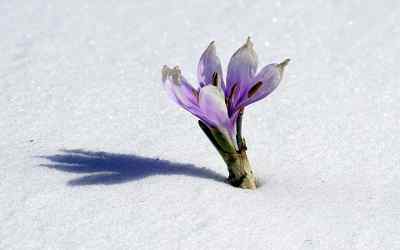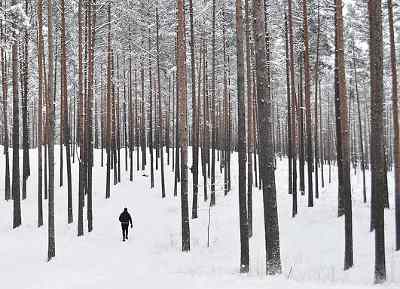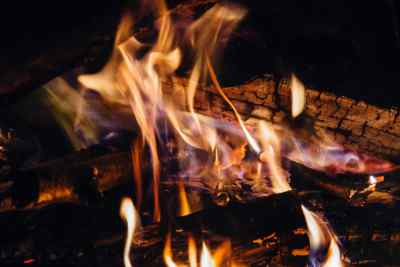COLD WEATHER SURVIVAL

A little knowledge, planning, and good equipment will allow you to defend yourself from the elements.
Wet Cold Weather Environments
During wet AND cold weather conditions you are facing a double threat. Water is very efficient at exchanging heat. So you must concentrate on protecting yourself from the wet ground and from freezing rain or wet snow.
WIND CHILL
Wind chill is often given on weather reports because cold coupled with high winds saps you heat much faster than the cold alone. Keep this in mind. Understand this. Knowledge is the key to survival.
Always keep your head covered. You can lose 40 to 45 percent of body heat from an unprotected head and even more from the unprotected neck, wrist, and ankles. I deer hunt and I learned this lesson the hard way. I used to bundle up to the extreme but after sitting for a while on a deer stand in cold weather I invariably got cold. I tried more and more clothes but that didn't seem to help. Now that I recognize just how much heat can be lost through your head (especially when you are losing hair as fast as I am haha) I don't have the getting cold issues that I always had in the past thanks to wearing insulation for my head.
Your head is basically a radiator. It has lots of blood flow for a couple of reasons but has very little fat for insulation. Good insulation on your head and neck is half the battle. Forgo this area and you are doomed.
Now that you realize your head is an important part of the heat loss equation we can look at how to keep your body warm by identifying four basic principles.
Four basic principles to keep warm!
Keep clothing clean.
Avoid overheating and sweating.
Wear clothes loose and in layers.
Keep clothing dry.
Keep clothing clean. This principle here is that your clothing is your insulation. Contaminating your clothes with dirt and oil etc reduces their insulating value.

This one issue probably contributes to a very large percentage of hypothermia deaths when people find themselves in a survival situation. Keep a cool head and think. Be smart! Remember your head is a great radiator. So if physical exertion starts to overheat you, removing headgear is the first line of action to keep yourself from sweating.
Wear your clothing loose and in layers. This goes for your feet as well. Wearing tight clothing restricts blood circulation and you need good circulation to keep your extremities warm. Feet and hands do not produce much heat. Most of your heat comes from the large muscles. Tight clothing reduces the amount of trapped air and it is this air that also acts as insulation... it isn't JUST the clothing themselves that is going to keep you warm.
Keep clothing dry. In cold temperatures, your inner layers of clothing can become wet from sweat and your outer layer, if not water repellent, can become wet from snow and frost melted by body heat or rain or standing water or even dew. Wearing water repellent outer clothing, if available is a great advantage.
OK so you know not to get wet but eventually you will get wet and you need to know some techniques to remedy the situation if you want to survive. Hanging wet articles of clothing is one method of drying them. Getting direct sunlight on them is a big help as well as in the wind. If this is not an option then maybe your body can be used as a dryer. Body heat can raise the garments temperature to facilitate evaporation. But first you should wring out as much excess water as possible.
In a campsite you should hang damp clothing inside the shelter near the top because heat rises. Using fire is the best option as it will dry clothing much faster than any of the other alternatives. Just be careful to not try and dry too quickly as you can shrink leather and burn clothing if they get too hot. Drying shoes and boots is one area that you are probably most likely to screw up. These articles do not dry easily so warping them or worse because you got them too hot is a big concern.
A heavy sleeping bag can be a life saver in a cold weather survival situation. Sleep in a survival situation where you don't have adequate equipment can be almost impossible and a sleeping bag allows you to sleep much much longer in cold weather than you would be able to without one.
Like your clothing it is imperative that you keep your sleeping bag clean and dry. Placing it directly on damp ground can quickly turn your one chance at a good night's sleep into a struggle for survival. Take the time to prepare a bed of leaves and such to keep the sleeping bag from contacting the wet cold ground.
HYGIENE
Although washing yourself may be uncomfortable in a cold environment, you really need to wash periodically to help prevent rashes. Once you have a rash it can quickly turn into something more serious when in a survival situation.
COLD INJURIES
When dealing with injuries and illnesses is imperative to take measures to prevent them from ever happening. Prevention is paramount.
HYPOTHERMIA
Hypothermia is the lowering of the body temperature. Initial symptom of hypothermia is shivering. First you shiver. Then you shiver to the point that you can't control it or stop it. This is your body trying to produce heat to warm itself. Sluggish thinking, irrational reasoning or next and eventually a feeling of warmth may occur. This is a critical point. You feel warm but you MUST at this point try to warm yourself up or you will die. However warming up brings on the sensation of pain again. But you must endure this or you will not make it. The will to survive is paramount here and it is at this point that many people give in and stop fighting to live. Death comes at around 77 degree core body temperature.
CAUTION
Rewarming the entire body in a warm bath, should shelter be reached should be slow because of the real risk of cardiac arrest and rewarming shock.
CAUTION
Never force an unconscious or semi-conscious person to drink.
Frostbite
Frostbite means having parts of your body freeze. Mild frostbite involves only the skin that takes on a dull whitish pallor. Deep frostbite extends to a depth below the skin. Feet, hands, and exposed facial areas are usually the first areas affected by frostbite. There is no fix once it has happened so prevention here is the only option available to combat it.
Trench Foot
Trench Foot occurs after many hours or days of exposure to wet or damp conditions at low temperatures just above freezing. The symptoms are a sensation of pins and needles, tingling, numbness, and then pain. The skin will appear wet, white and shriveled. Eventually if the condition is not corrected with dry warmth the skin will turn red and then a bluish or black. The feet will swell. Walking becomes difficult and the feet feel heavy and numb. In extreme cases, the flesh dies and it may become necessary to have the foot or leg amputated. The best prevention is to keep your feet dry.
Dehydration
When clothed for cold weather, you must drink water to replace lost fluids. Your need for water is as great in a cold environment as essential just like it is in hot weather. One way to tell if you are becoming dehydrated is to check the color of your urine. The darker the urine the worse the dehydration. Snow Blindness
The reflection of the sun's ultraviolet rays off a snow causes this condition. The symptoms of snow blindness are a sensation of grit in the eyes, pain in and over the eyes that increases with eyeball movement, red eyes, and a headache that intensifies with continued exposure to light. Continued exposure to these bright snowy conditions will result in permanent eye damage. To treat snow blindness, bandage your eyes until the symptoms disappear, you can basically make a set of eye patches with a hole just big enough to see through to help or prevent the occurrence.
You can prevent snow blindness by wearing sunglasses.
SHELTERS
Building a shelter is an important skill in surviving a cold weather event.
Shelter material should be made of insulator not conductors such as metal.
Be sure your shelter has some ventilation especially if you intend to build a fire in it. The shelter should be no larger than needed so that it is easier to heat. In a survival situation smaller is better when it comes to building a temporary shelter.
Never sleep directly on the ground or put clothing, sleeping bags or other equipment on the ground. Lay down a bed of leaves, grass, or other insulating material to keep the ground from absorbing your body heat.
If your shelter is good then be wary of Carbon monoxide poisoning. Never sleep with a lamp or heater burning. Carbon monoxide is a great danger. It is colorless and odorless. Any time you have an open flame, it may generate carbon monoxide. Always check your ventilation. Even in a ventilated shelter, incomplete combustion can cause carbon monoxide poisoning. Usually, there are no symptoms.
Snow Cave Shelter
The snow cave shelter is an effective shelter because snow is a good insulator and wind screener. To build, you will need a snow drift of at lest 9 feet high. Keep the roof arched for strength and to allow melted snow to drain down the sides. Build the sleeping platform higher than the doorway. Keep away from the cave's walls or better yet dig a very small trench between you and the wall to keep yourself dry while inside should any runoff occur.
FIRE

Remember that the smoke, smell, and light from your fire may reveal your location to anyone around. When the shit hits the fan it might be a good idea to take measures to keep your fire as small as possible and as hidden as possible. Light travels a long ways and you don't want to have others hone in on you while you are sleeping.
Some wood burns easier than others. For example, pine trees that contain resin and tar create more and darker smoke than deciduous trees but they are also fairly easy to light. So pine would be the choice to get a fire started but then switching to hardwoods later can help with less smoke, longer slower burns.
Don't overlook man-made objects as fuel for your fire such as plastics. But avoid breathing the smoke.
For heating purposes, a single candle or a small fire the size of your hand provides enough to heat to keep you warm if you have built an enclosed shelter.
Tip:
Avoid drinking a lot of liquid before going to sleep. Getting out of a warm sleeping bag at night to relieve yourself means less rest and more exposure to the cold.

